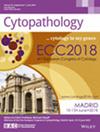Plasmablastic Lymphoma in the Submandibular Region Diagnosed by FNAC: A Case Report and Literature Review
IF 1.1
4区 医学
Q4 CELL BIOLOGY
引用次数: 0
Abstract
FNAC is effective in the diagnosis of plasmablastic lymphoma. Immunophenotypic profile and morphological features are crucial for accurate diagnosis and cell block is an excellent tool for IHC. The literature review confirms the importance of FNAC as a diagnostic tool for PBL.
The authors present a literature review of FNAC-diagnosed plasmablastic lymphoma (PBL) cases and present a case of PBL in an HIV patient diagnosed by FNAC. Immunophenotypic profile and morphological features are crucial for accurate diagnosis and cell block is an excellent tool for IHC. The current study highlights the efficacy of FNAC in diagnosing PBL.
通过 FNAC 诊断的颌下区浆细胞性淋巴瘤:病例报告和文献综述。
目的:本研究旨在对FNAC诊断的浆细胞性淋巴瘤(PBL)病例进行文献综述,并介绍一例经FNAC诊断的艾滋病患者的PBL病例:本研究旨在对FNAC诊断的浆细胞性淋巴瘤(PBL)病例进行文献综述,并介绍一例经FNAC诊断的艾滋病患者的PBL病例:方法:在8个数据库中进行文献综述,在不限制受累部位的情况下汇编FNAC诊断的PBL病例信息:结果:文献综述包括23例PBL,其中13例(56.5%)累及头颈部。患者平均年龄为 49 岁,男女比例为 1.9:1,13 例(56.5%)患者为 HIV 阳性。23 名患者中有 10 人(43.5%)的 Epstein-Barr 病毒(EBV)检测呈阳性。共进行了 21 次 FNAC 手术和 2 次细胞学涂片检查。7例(30.4%)患者出现浆细胞/浆细胞形态。在 17 个病例(73.9%)中观察到大细胞。10例(43.5%)出现多形性。91.3%的病例通过细胞学诊断为恶性肿瘤。在 20 个接受一致性评估的病例中,发现完全一致的有 8 例(34.8%),不一致的有 12 例(65.2%)。我们还报告了一例通过 FNAC 诊断出 PBL 的病例,患者为 55 岁男性,左侧颌下腺区域有一个疼痛、坚硬、不活动的肿块,大小约 10 厘米,病程 1 个月。患者接受了 FNAC 检查,并进行了细胞学涂片和细胞块(CB)制备。用 Diff-Quik、HE 和巴氏染色法染色后,观察到大量细胞呈现浆液性形态。免疫组化分析显示,LCA、CD3、CD20、Pax5、CD79a、ALK 和 HHV-8 阴性,CD138、MUM1 和 Ki-67 阳性(100%)。EBV 阳性也得到证实,从而确诊为 PBL:本研究强调了 FNAC 诊断 PBL 的有效性。通过 FNAC 观察到的免疫表型和形态特征,结合免疫组化 (IHC) 和原位杂交,对准确诊断至关重要。文献综述强调了 FNAC 作为 PBL 诊断工具的价值,它显示了较高的细胞学诊断率和显著的细胞组织学一致性。
本文章由计算机程序翻译,如有差异,请以英文原文为准。
求助全文
约1分钟内获得全文
求助全文
来源期刊

Cytopathology
生物-病理学
CiteScore
2.30
自引率
15.40%
发文量
107
审稿时长
6-12 weeks
期刊介绍:
The aim of Cytopathology is to publish articles relating to those aspects of cytology which will increase our knowledge and understanding of the aetiology, diagnosis and management of human disease. It contains original articles and critical reviews on all aspects of clinical cytology in its broadest sense, including: gynaecological and non-gynaecological cytology; fine needle aspiration and screening strategy.
Cytopathology welcomes papers and articles on: ultrastructural, histochemical and immunocytochemical studies of the cell; quantitative cytology and DNA hybridization as applied to cytological material.
 求助内容:
求助内容: 应助结果提醒方式:
应助结果提醒方式:


